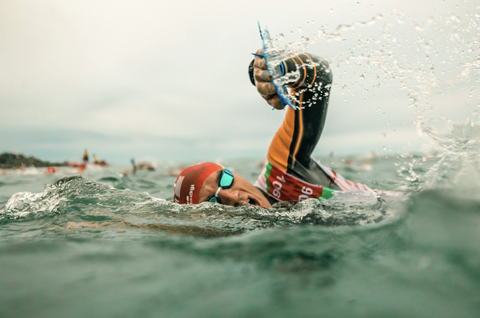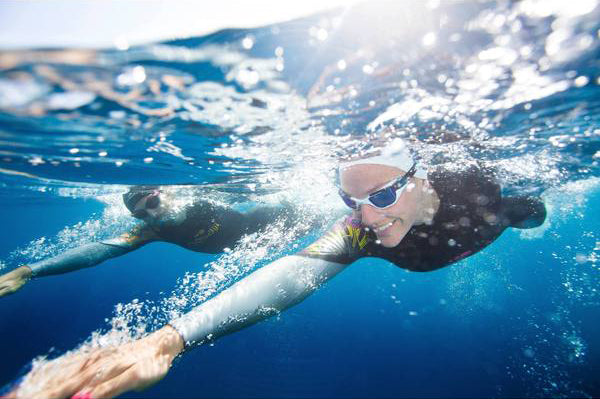Open water swimming is a great workout, whether you’re training for a triathlon, a swim event, or snorkeling to check out fish and other marine life. While we love our water adventures, it’s important to be aware of some of the risks associated with open water swimming. These risks don’t mean you should be afraid to venture out there, but sometimes being prepared and taking precautions can make all the difference.
The following are some tips to help you stay safe when swimming and snorkeling in the open water:
Rule #1: Never swim alone.
When you head out into the open water, make sure you go with a partner: someone who’s looking out for you, and in turn, you’re looking out for them. The lifeguard isn’t your “swim buddy.” Even though it’s great to have lifeguards on duty, they have many people to track to be solely concerned with your safety. Swimming can often more fun when shared too. Never swim alone.
Get comfortable in open water.
Already at the beach? Gradually build your confidence swimming in open water. It’s ok if you don’t feel “ready” right away - allow yourself time to practice, whether that’s in the pool or closer to shore. Begin where you feel at ease, and practice going further out from your base at a pace that works for you. With more experience comes an increased level of comfort.
Know the conditions.
Check the water temperature and weather conditions prior to heading out. It’s not safe to swim in lightning and thunderstorms. If the weather turns, make your way back to shore. If water temperatures are cold, choose an appropriate wetsuit and limit your time in the water.
Understand currents.
The ocean is full of uncontrollables, including rip tides, other currents and waves that may sweep you away from where you planned on swimming. Choose a static “beacon” on the shore, or your boat, to make sure you aren’t unknowingly being swept away.
If you do get caught in a riptide, don’t panic. Calmly swim parallel to shore to get out of it. Don’t try to swim against, or fight the current, as this can cause further panic and exhaust you.
Stay calm.
As mentioned above, never panic. If you start feeling uncomfortable, the very first step is to stay calm. Alert your swim buddy, and calmly swim back to where you feel comfortable.
Check your surroundings.
Make sure you don’t inadvertently swim too far away from your swim buddy, the shore or your boat. As fun as it is to cruise around in the water, make sure you observe your surroundings and have eye contact with your swim buddy. Having a static point where you can measure how far you’ve swum is important so you save enough energy to swim back to shore too.
Take a break.
If you start feeling exhausted or uncomfortable, take a break. Either tread water, or calmly make your way back to shore.
Know your underwater creatures.
It’s always good to know what creatures to look out for - i.e. steer clear of jellyfish and other poisonous fish. Generally, a good rule of thumb is to look, but not touch anything; leave the delicate sea floor the way you found it.
Have a plan.
Before heading out, it’s always good to have a basic plan - where you plan to swim, how far you plan to go, and how long you plan to be in the water. It’s always smart to alert someone on shore of your swim agenda for the day. Even though you have a swim buddy (never swim alone), check in with the lifeguard before heading out.
Choose the right equipment.
Are you swimming or snorkeling? Is the water cold enough for a wetsuit? Choosing the right equipment for your open water activity is important. If swimming, we recommend using swim goggles and the appropriate swim attire for getting a workout.
For snorkeling, our Easybreath® mask, originally innovated by Decathlon, is specifically designed to give swimmers a panoramic field of view underwater, while making breathing easier by allowing you to breathe easily through your nose and mouth.*
If water temperatures are over 75-80 degrees, using a wetsuit for extended periods could cause heat exhaustion. Similarly, for lower temperatures, a wetsuit is advised to keep your body and core warm. USA Triathlon’s standard regulations on wetsuits are as follows:
- Under 50 degrees: Not suitable for open water swimming, even with a wetsuit
- 50 to 65 degrees: Suitable for open water swim, but wetsuit is highly advised
- 65-78 degrees: Suitable for swimming with or without a wetsuit. Sleeveless suits are popular at this temperature.
- 78-84 degrees: Wetsuits are not advised (triathlon race directors use discretion on whether or not wetsuits are even allowed in a race situation).
- Over 84 degrees: Wetsuits should not be worn (in triathlons, wetsuits are not allowed if water temperatures exceed 84 degrees). Consider lighter swimwear.
* The Easybreath® mask was designed for snorkeling, not swim workouts. Read our FAQs on using the Easybreath® mask.
Relax and have fun.
There’s a lot to think about when you’re swimming in the open water. While it’s important to be prepared, don’t forget to have some fun too - and relax! Trust your preparation, and if ever you feel like you’re getting uncomfortable, remain calm and head back to shore.

Whether you’re heading out to get exercise or basking in the beautiful underwater world, there is much to explore in the underwater world. However you plan to enjoy your open water adventure, it’s important to follow these basic tips to stay safe when you’re in the open water - and always remember rule #1 - never swim alone.
Happy swimming from the team at Decathlon!











